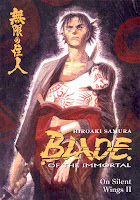 Creator: Hiroaki Samura
Creator: Hiroaki Samura
U.S. publisher: Dark Horse
ISBN: 9781569714690
Released: September 2000
Original release: 1996
Awards: Eisner Award, Japan Media Arts Award
Dark Shadows is the sixth volume of Hiroaki Samura’s manga series Blade of the Immortal as published by Dark Horse. The English volumes and the Japanese volumes collect slightly different chapters and so Dark Shadows is actually most closely equivalent to the fifth volume published in Japan and released in 1996. Dark Shadows was published in 2000, the same year that Blade of the Immortal won an Eisner Award. In 1997 the series also won a Japan Media Arts Award. Blade of the Immortal was one of my first manga series and it remains one of my favorites. On Silent Wings II, the volume that immediately precedes Dark Shadows, ends the first major story arc of Blade of the Immortal. Dark Shadows begins the next arc, introducing new characters and new complications to the story.
The Ittō-ryū continues to dominate the other dōjō in Edo, ultimately catching the eye of the shogunate itself. But the pressure applied by the shogunate isn’t the only thing that Anotsu, the charismatic leader of the Ittō-ryū, has to worry about. A newly formed sword school is bent on the destruction of the Ittō-ryū. Using methods as ruthless as the Ittō-ryū’s own, they have been steadily taking out Anotsu’s leading swordsmen. Rin, too, has become more confident in her decision to kill Anotsu in revenge for her parents’ murder. She continues to train with Manji to improve her swordsmanship. The confrontations between Manji and the members of the Ittō-ryū have brought him to the attention of the new sword school, as well. They would like him to join them in their fight against Anotsu and the Ittō-ryū.
One of the things that Samura does exceptionally well in Blade of the Immortal is establishing moral ambiguity in his characters. No one is truly good or bad—the “bad guys” have honorable qualities and the “good guys” have faults. It all depends on the perspective of the individual characters. A good example of this in Dark Shadows is Magatsu, one of the only members of the Ittō-ryū to survive an encounter with Manji. He’s more than willing to cut down other swordsmen, usually after being provoked, but maintains his own code of honor along with his grudges. Throughout Blade of the Immortal, Magatsu is shown to be one of the more decent characters. On the other hand, Dark Shadows see the introduction of Shira, a member of the swords school fighting against the Ittō-ryū. In his case, he is extremely cruel and even sadistic in his methods. He’s made his living killing others for money and has come to enjoy it.
Up until this point, much of Blade of the Immortal has focused on Rin and Manji and their journey. But they don’t even appear until the final half of Dark Shadows. Instead, Samura takes the opportunity to explore the Ittō-ryū more deeply. Magatsu in particular is developed as an important character. Dark Shadows also introduces new and very dangerous players to the story. The volume downplays some of the more fantastical elements of the story, but that may just be because Manji wasn’t involved in any of the fights. However, there’s no question that Blade of the Immortal remains a very violent series. Dark Shadows marks an excellent start to the new story arc and I look forward to seeing how things continue to develop in the next volume, Heart of Darkness.




